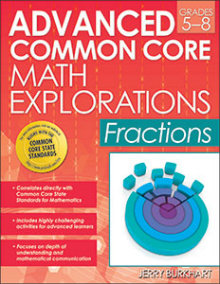Meeting the Challenge of Teaching Fractions
Advanced Common Core Math Explorations: Fractions, Grades 5-8
By Jerry Burkhart
(Prufrock Press, 2015 – Learn more)
Fractions? Yuck! For the most part my students do not seem to enjoy fractions. They come to middle school without a deep understanding of what they actually mean. This book by Jerry Burkhart could change those feelings into curiosity and produce true knowledge of the essence of all types of fractions.

The explorations are broken down into stages, one through three, and finishing all three stages is not expected. Even the stage one questions are interesting and challenging, but are also the most attainable for our students. Each exploration includes not only a student handout, answers, and explanations, but also a very helpful introduction page, teacher’s guide, and wrap up section.
Exploring the Explorations
The introduction page for each exploration offers you four sections: a clear list of materials, the prior knowledge required for students (including which of the explorations in this book should have been completed already), a set of learning goals, and information about launching the exploration.
Both content goals such as “represent sums of fractions using area models” and math practice goals such as “persevere in solving challenging problems” are included in the learning goals. In order to compare goals across explorations, I would have liked to see those listed separately. The Launching the Exploration section is sometimes difficult to sort out until after you read through the questions in the student handout.
The second piece of each exploration is the student handout, which is the heart of the exploration. Each begins with a seemingly simple question, leading to another more challenging question, leading to the most advanced questions about the fraction exploration. The student handouts, which are either two or three pages long and can be reproduced for students, leave a little space for writing answers, but I am certain students would benefit from having scratch paper as well.
A helpful teacher’s guide
Third, we have the teacher’s guide where answers are listed and thoroughly explained. Burkhart could have just given us the answer with a short explanation, but he takes the time to really explain why the answer is true and how the students might get there and understand it.
My favorite part of this section of each exploration is the “questions and conversations” that Burkhart offers. It is clear he has completed these explorations with many students and groups, and he suggests leading questions and sentences to help students get “unstuck” throughout the process of exploring the math. He also includes useful “teacher’s notes” in boxes on the sides of some pages. I learned a lot from these two techniques.
Finally, there is the wrap up which includes three sections: share strategies, summarize, and further exploration. In the share strategies section, Burkhart gives suggestions on how to get students to share their ideas with each other, sometimes offering comparison questions. In the summarize section, he explains how to summarize and expand on key ideas. For further exploration, he offers even more extensions for students who have accomplished the entire student handout and still want to take it further, such as finding new patterns, explaining why something is true, or providing algebraic solutions.
The explorations approach offers a range of challenge
Even though I have not worked through these explorations with any students yet, I can see how they would encourage curiosity and promote deep understanding of fractions and how they work. The explorations would also support students in extending their learning of fractions and help them in later math classes. Our advanced learners may feel like fractions are easy or boring, but not anymore! With these explorations, they can go as far as any mathematician to understanding the complexity of fractions of wholes.
Common Core requires us to go beyond algorithms to understanding. In the realm of fractions, this is difficult for many teachers and students. Burkhart’s book will help us challenge ourselves, teachers and learners, by engaging all of us with interesting questions that lead us to deep understanding. I highly recommend this book and look forward to trying out the explorations with my students.
Karen Bloom is a life-long learner and teacher. She currently teaches math, co-advises Safe Space Club and Safe School Ambassadors and a lunch time Chill Zone, and is also a part time math coach at Piedmont Middle School in Piedmont, California. Her passion is for getting to know her students and colleagues as people and then helping them get from where they are to where they want to be.






























